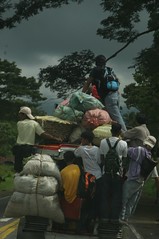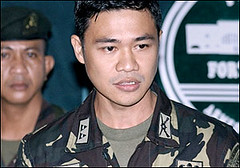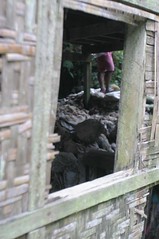(I'm sure this is not only an eye opener but also a test case for administrators of state colleges and universities. How good are schools in balancing the act between campus freedom and regulation. They'll have to juggle between this two ideals. Honestly, it isn't pleasant to see university officials being "grilled" with questions and cynicism by the public. I for one did not want, if only it wasn't my job, to ask Dr. Julieta Ortiz any question during the press conference. If I am not a journalist, I would let it pass for the wheels of juctice to move. But a life of a student was wasted here, and possibly many more, if issues like this do not surface for public discussion. In one way, this could serve as an eye opener not only for USEP, but also for other colleges, universities and other institutions of learning. This is also a case for study in a month when we were supposed to be "prepared for emergencies and disasters". I pray for the soul of Cheryl, the welfare of her family. Also, prayers for the officials, teachers and students of USEP who are in the limelight of public scrutiny over this tragedy.) USEP yet to probe student's death, ready to face chargesDAVAO CITY (Courtesy of MindaNews / July 28) -- The University of Southeastern
Philippines (USEP) could not yet establish liability over the tragic
pageant night eight days ago that scorched to death a campus beauty
contestant, university president Julieta I. Ortiz told a press
conference Friday.
But Ortiz said the university, southeastern Mindanao's largest
state-owned higher educational institution, has assumed full
responsibility and was ready to face charges that might be filed
against them.
"The administration is taking care of the incident and assumes its
moral duty to the Sarate family," Ortiz read USEP's official
statement.
She said a fact-finding committee created on July 25 would be the one
to investigate the incident and identify those who should be liable.
USEP could not yet say what would be its next move because it will be
based on the findings of the committee, she added.
Sarate, 16, was a first year Bachelor of Arts major in English student
from Calinan district. She told family members she wanted to graduate
from college so she could work abroad. On June 20, according to the
statement, she joined the search for the Lady and Lord of Utopia, an
annual beauty pageant organized by the Guild of English Students. At
around 7:15 that evening, her costume caught fire from a candle used
as props along the catwalk. She was rushed to the Mindanao Burn Center
of the Davao Medical Center (DMC) and was admitted with third degree
burns. She died on July 23.
Ortiz said she did not want to preempt the results of the fact-finding
body and referred all queries regarding the details of the incident to
them. Ortiz said the investigation was due to submit a report on
August 31.
Dr. Daniel Ungay, who chaired the fact-finding committee, told
MindaNews they were yet to meet Friday afternoon to start the
investigation. The rest of the members of the committee included the
university's chief administrative officer, the faculty club president,
secretary of the university's board of regents, the president of the
campus' student council and an assistant.
Ortiz said their main concern for now was to extend whatever help to
the Sarate family. She denied they were remiss of their duties and
allegedly depended on assistance from the city government.
She said they gave around P30,000 for the victim's hospitalization,
through Cheryl's mother. The amount included donations from the
faculty and students. She also showed photocopies of checks worth
P67,134.37 issued by the university for funeral and burial expenses of
the victim.
But the family said the school was too slow in probing the incident.
Antonio Sarate, the victim's father, said the investigation was
started only Friday, eight days after incident, and considered as "too
long" the time, 38 days, given to the committee to finish its work.
"The administration should not delay its investigation," he said.
Ungay said the timetable was meant to gather enough information "given
the circumstances of students who have classes". "But we will try to
submit the report before August 31," he said.
Alfie Keith Apalit, USEP's Obrero Campus Student Council (OCSC)
president, said the administration should already have a stand on
liability at this time.
"The OCSC stands firm in addressing the issue on the lack of safety
measures, facilities, and the available help (first aid) that could
have prevented and or saved the life of Cheryl Sarate from that
terrible incident," the student council's press statement on July 27
said.
That the university did not report the incident to the fire station
accounts for some liability, Orencio B. Grado, senior fire officer of
the Bureau of Fire Protection told MindaNews Friday.
Grado, member of a BFP team investigating the incident, said they only
knew of the incident from television news. "That's a standard
operating procedure," he said.
"It would be most prudent for the school administration to assume
responsibility, said lawyer Ranuelo Leonar who was interviewed by
ABS-CBN radio on August 27.
He said the university could be liable for reckless imprudence
resulting to homicide because the incident happened within school
premises.
"What happened? Wasn't there a program coordinator overseeing the
event?" he asked.
USEP's public information office said if the committee finds anyone
liable, the university would impose appropriate administrative
penalties. "Everything now depends on the findings of the committee,
Melanie C. Pagkaliwagan," USEP's public information officer told
MindaNews.
"It's an eye opener for us to fully implement our school policies,"
Ortiz told reporters, including more than a hundred students who
attended the press conference held at the social hall, where the
incident that killed Sarate was held eight days ago. (Walter I.
Balane/MindaNews)




